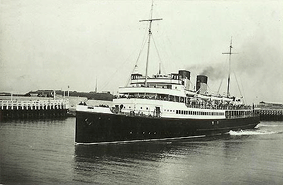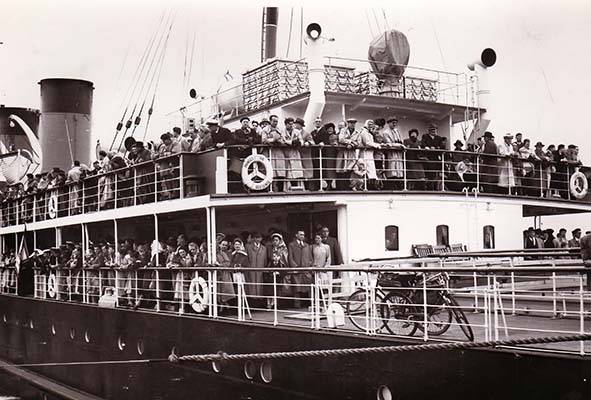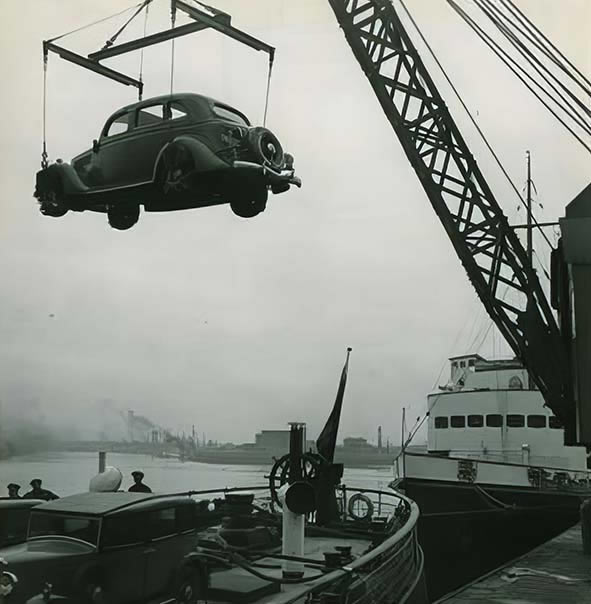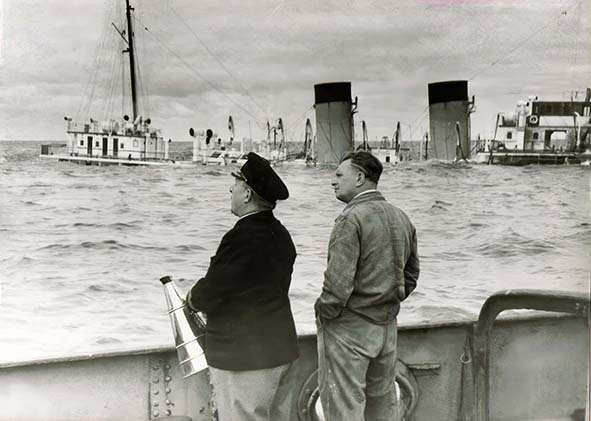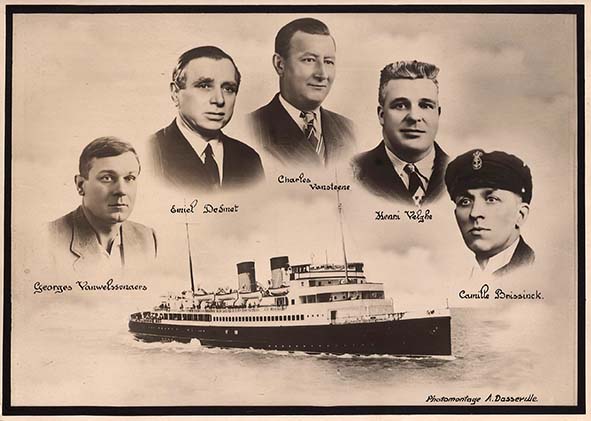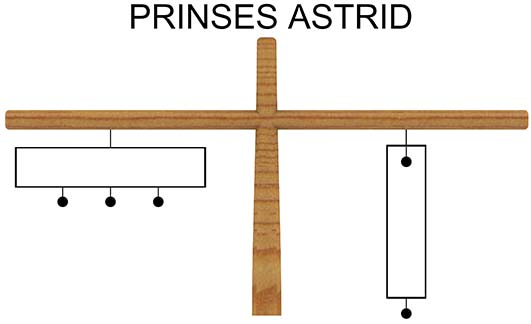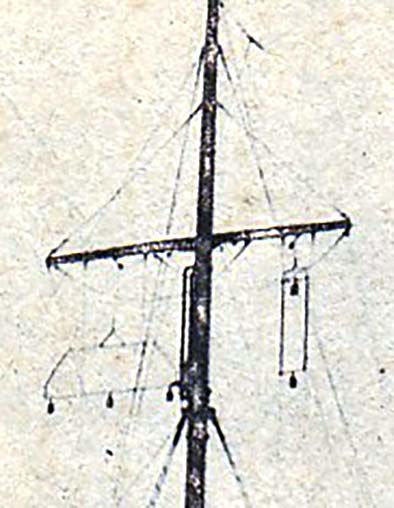In de zomer van 1928 bestelde de minister Lippens twee nieuwe schepen bij Cockerill met de bedoeling om een reeks van vier te bouwen. Het waren de Prinses Astrid en de Prince Léopold. Respectievelijk bouwnummers 638 en 639 van Cockerill. De Oostende-Dover lijn had dringend nieuwe vaartuigen nodig. De naoorlogse periode en de economische gevolgen ervan hadden de schatkist nog niet toegelaten om kredieten vrij te krijgen voor dit doel. De oude schepen hadden er al na die moeilijke jaren loodzware diensten op zitten. Aan de andere kant stond de technologische vooruitgang niet stil en werden machines vervaardigd die meer kracht dan 15000 Pk konden ontwikkelen. Zo kon men starten aan de nieuwe “Prinsenvloot”. De afmetingen bepaald in het contract bedroegen als totale lengte 109.60 meter, 14 meter breed en een hoogte van 7.55 meter tot aan het brugdek. Het maximum vermogen werd bepaald op 15 400 Pk voor een verplaatsing van 2533 ton. Deze kracht werd opgewekt met zes turbines. Er kon 25 kg druk worden opgewekt met een stoomhitte van 374 graden. De diepgang mocht niet meer dan 3.05 meter bedragen en de minimum snelheid werd bepaald op 23.5 knopen. Een bijzonder detail is dat de Parsons turbines en ketels van Babcock & Wilcox konden worden gestookt met kolen maar ook de nodige installatie werd voorzien om met mazout te stoken. De lasten voor het in gebruik nemen en testen van de installatie op mazout werd echter niet door Cockerill genomen maar lag bij het Zeewezen. Daardoor konden de schepen 150 ton kolen laden en 100 ton mazout.
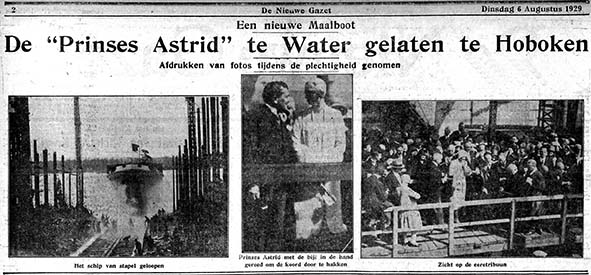
De feestelijke lancering van de Prinses Astrid op 3 augustus 1930.
Het was de bedoeling om het eerste schip tegen 1929 in de vaart te brengen maar dat lukte Cockerill niet. De Prinses Astrid was namelijk gepland om in het zomerseizoen 1929 te worden ingezet. Maar de economische toestand op wereldvlak stond achter de deur. Pas op 3 augustus 1929 werd de Prinses Astrid om 15u00 in Hoboken te water gelaten. De verdere afwerking nam nog enkele maanden in beslag en het schip kon pas op 15 april 1930 de eerste proefreis naar Oostende doen. Op 19 april 1930 kon ze dan definitief uit Hoboken naar Oostende vertrekken voor een hartelijk en feestelijk ontvangst. Enkele dagen later op 24 april vertrok de Prinses Astrid om 10u30 voor haar inhuldiging en Maiden trip naar Dover met commandant Lauwereins, 1lt Goor en lt Wynants. Op het staketsel stonden grote menigten het mooie vaartuig uit te wuiven. Aan boord een groot aantal belangrijke genodigden. Het weer zat ook geweldig mee. Sierlijk gleed het schip uit de haven van Oostende richting Engeland. Het gedaver van de machines waren nauwelijks hoorbaar. Tijdens de overvaart van iets meer dan drie uren werd het schip aan de genodigden uitvoerig getoond en er werd hen een feestelijke maaltijd aangeboden. In Dover aangekomen kwamen een groep journalisten van de pers aan boord en werden de enkele Engelse functionarissen te woord gestaan door de heer Devos. Het eerste schip van de nieuwe generatie werd hartelijk onthaald. Het was namelijk een schip waarop de modernste maritieme voorzieningen waren geïnstalleerd. Er was nauwkeurig gekeken tijdens de bouw naar het materiaal, kwaliteit en comfort. Een nieuwigheid waarmee uitvoerig werd uitgepakt was dat het schip voorzien was voor een radiotelefonische verbinding. Zo kon de journalist via deze voorziening vanop het schip met de hulp van radio telegrafist Willock van de Marconi maatschappij verslag uitbrengen aan zijn redactie. Het gesprek ging draadloos lang de ether tot aan het zendstation in Oostende en werd vervolgens na zuivering via de telefoonlijn op bestemming gebracht. Een was een unieke ervaring voor de persmensen.
Er was echter geen reden tot juichen over de prestaties van de machines. Men was al bij de eerste reizen niet tevreden over de machines die soms weigerden en ook niet de beoogde snelheden haalden. Nieuwe technologieën hebben uiteraard ook hun kinderziekten. Bij de Prinses Astrid was dat ook niet anders. Kwade tongen spraken van sabotage. Maar dat gerucht werd algauw door de Minister de kop ingedrukt. Gelukkig was er in het contract vastgelegd dat er de eerste zes maanden een afgevaardigde van Cockerill voor de machine meevoer. Met regelmaat had het schip met panne te kampen. Na enkel weken moest het schip terug naar Antwerpen voor nazicht en aanpassingen. Op het einde van de waarborgperiode moest ze nogmaals naar Antwerpen voor een tijdsduur van drie maanden geschat. De gecombineerde mogelijkheid om zowel kolen als mazout als brandstof te gebruiken werd in het eerste jaar een zware belemmering voor de dienst. In de kamer en de pers werd de kostprijs van het schip nogal in de verf gezet. Met een kost van 35 135322 Fr. lag dat zwaar op de maag. Vooral omdat men terug moeilijke economische tijden diende te trotseren. Zo haalde de wisselkoers van de pond in 1933 tegenover de Belgische frank op een bepaald tijdstip niet minder dan 176 Fr.
Begin mei 1933 ontstond toch wel enige paniek wanneer na aankomst in Dover bij het opruimen van het schip een Duitse handgranaat in de toiletten werd gevonden. De Politie en bevoegde diensten in Dover werden verwittigd die deze onschadelijk maakten. Men was van mening dat een toerist deze in Flanders Field had gevonden en op het laatste moment deze aan boord achtergelaten had om geen problemen met de Douane te krijgen.
Op 3 september 1933 was commandant Vanden Bossche om 01u00 uit Oostende vertrokken met 300 reizigers wanneer op een afstand van de Sandetti een man zich over boord had geworpen. Een uur lang zocht de maalboot tevergeefs naar de man terwijl het reisgoed werd doorzocht maar geen enkel identiteit kon worden achterhaald.
In april 1934 had een Poolse 22 jarige jonge man zich ’s nachts aan boord van de Prinses Astrid kunnen verstoppen. Eenmaal in volle zee werd hij teveel gekweld door de grote honger en moest hij zich vertonen. Hij werd bij aankomst terug in Oostende overgedragen aan de autoriteiten. De man was al geruime tijd zonder werk in Oostende. Het waren harde tijden.
Omdat het juist hard tijden waren en aldus de inkomsten drastisch omlaag gingen door de dure pond organiseerde het Zeewezen uitstappen, of zeg maar excursies met de maalboten. Zo werden op verschillende datums reizen ingericht naar Margate, Rye, Newhaven, Brighton, Hastings, Canterbury, Calais, Boulogne, Duinkerke, Antwerpen, Amsterdam, Rotterdam, Vlissingen, Middelburg, Ijmuiden, De Haag enz.. De prijzen lagen verschillend naargelang het vertrek vanaf het treinstation. Meestal betaalde men tussen de 145 en 175 Bfr. voor een excursie. Men kwam er zelfs aan toe om aperitiefconcerten op zee in te richten. Het schip vertrok om 10u30 en kwam om 12u30 terug in Oostende voor een prijs van 10 Fr. Zo werd het varend materieel toch enigszins bezet en gebruikt in de zomer. Het initiatief genoot enorme bijval. In die mate dat soms twee maalboten voor de dag moesten worden ingezet. Velen brachten hun lunchpakket mee of genoten van een maaltijd aan boord van de maalboot.
De heersende repressie bracht ook Cockerill tot stilstand. Daarom besloot de overheid om de werf terug op te starten met de bouw van een nieuw schip. Namelijk de Prince Baudouin.
In maart 1935 moest de Prinses Astrid terug naar Antwerpen voor herstellingen. Er moest een nieuwe schroefas van 4 ton geplaatst. Dergelijke werken konden enkel in Antwerpen. Daar was, zeg maar het hoofdmagazijn van het Zeewezen waar de reservestukken voor de maalboten lagen. Zoals gewoonlijk ondernam men de reis naar Antwerpen met een aantal toeristen aan boord.
Op 4 april was de Prinses Astrid al terug in dienst wanneer er bij aankomst in Oostende om 20u45 een speciale controle van de Douane plaats greep. Elke reiziger werd grondig onderzocht in de douanezaal. Een koppel werd opgemerkt dat zich wat ongebruikelijk gedroeg en afzonderlijk genomen voor grondiger onderzoek. Bij elk van de twee vond men een groot aantal gouden pennen die op een riem onder de kleding verstopt waren en op het lichaam gedragen. De vrouw had een groot aantal in het korset verborgen. Samen bedroeg de vondst een waarde van ongeveer 50 000 Fr. Het proces verbaal werd opgemaakt met gewone schrijfpennen.
In juni 1936 kreeg de Prinses Astrid een bijzondere opdracht om op 15 juni reizigers af te gaan halen van een Cunard White Star Line schip de Lancastria dat onderweg was uit Amerika. Het schip was op 5 juni uit New York vertrokken waaronder een dertigtal uitgeweken Vlamingen en Amerikanen die België wilden bezoeken. Het schip van 17000 ton kon uiteraard de haven van Oostende niet aandoen en men verzocht de reizigers op zee te gaan afhalen. In Amerika had men publiciteit gemaakt voor Oostende waardoor 96 passagiers voor Oostende wilden ontschepen. Commandant Timmermans vertrok om 08u30 richting Lancastria die aan de horizon zichtbaar was. Men vreesde voor de goede gang door het woelige weer. De Lancastria lag een drietal mijlen voor de kust voor anker. Ruim een tijdje manoeuvreerde de Prinses Astrid om in een goede positie naast de Lancastria te geraken en om een loopbrug te kunnen plaatsen voor de ontscheping. Terwijl de reizigers en hun bagage ontschepen dronken de commandant Timmermans en directeur Goor een kopje koffie met de kapitein van de Lancastria in de mooie zaal van het prachtige schip. Even later kan de Prinses Astrid losmaken en met de ontscheepten terug richting Oostende varen terwijl de Lancastria het anker licht en zijn reis verder zet. In Oostende stonden tal van familieleden de aankomende Vlaamse Amerikanen op te wachten. Het weerzien na vele jaren was dan ook intens.
Eind juni had de Prinses Astrid in de nacht Dover verlaten en had voordien zo’n 20 minuten vroeger de Prinses Joséphine Charlotte voorbij gevaren ter hoogte van de Ruytingen wanneer de luitenant Jensen iemand hoort roepen. De luitenant verwittigde onmiddellijk de commandant Timmermans die het bevel gaf te stoppen. De Prinses Astrid was ondertussen al een eind voorbij de plaats van het geroep. Het duurde zowat 20 minuten wanneer de bemanning en de 70 passagiers de drenkeling in het oog kregen. Men begon al stilaan om 03u30 het daglicht te zien en er werd een boot uitgezet. Die kon de drenkeling oppikken die al zowat een uur in het water spartelde en de uitputting nabij was. Bij aankomst in Oostende om 05u00 werd de man naar het hospitaal gebracht voor verzorging. Het bleek Frederic Michaelis te zijn, een Engelsman uit Chelsey die voordien aan boord van de Prinses Joséphine Charlotte zat en uit wanhoop van boord was gesprongen terwijl niemand dat had opgemerkt. De man was een getraind zwemmer en slaagde erin uit instinct om een uur boven water te blijven tot wanneer de Prinses Astrid hem had opgemerkt. Na wat gerecupereerd te zijn van de uitputting gaf hij toe de wanhoopsdaad te hebben gepleegd. Aan boord van de Prinses Joséphine Charlotte vond men zijn regenjas en vest waarin brieven gericht waren aan personen in Engeland. Op 9 juli mocht Frederic wel het hospitaal verlaten maar men wilde hem niet alleen laten vertrekken. Zijn broer werd uit veiligheid uitgenodigd om hem te komen halen en terug te brengen naar zijn familie.
Op 6 augustus 1937 had de Prinses Astrid in de haven van Oostende een aanvaring met de Prince Charles. De Prinses Astrid liep wat schade op maar kon toch verder de dienst uitvoeren. Later in Augustus ging ze naar Antwerpen voor herstellingen.
In januari 1938 mochten de maalboten onder strenge bewaking zendingen goud voor de Nationale Bank transporteren. De Prinses Astrid zelf had de woensdag 12 januari bij aankomst te Oostende 49 verzegelde kisten mee.
Op 12 februari heerste een flinke storm voor de kust. De Prinses Astrid die moest om 19u30 aankomen probeerde tot viermaal toe om de havengeul te benaderen maar telkens belet door hevige regen, sneeuw en hagelbuien. In de hevigheid werkten de lichten en seinen van de pier niet meer door korstsluiting. Noodlichten dienden te worden aangebracht. Uiteindelijk besliste commandant Aspeslagh om aan Duinkerke te gaan schuilen met 260 reizigers aan boord. De zondag morgen om 07u00 kon ze dan wel de haven binnen komen.
Op 31 mei mocht de Prinses Astrid opnieuw de taak op zich nemen om enkele reizigers af te halen van boord van de Lancastria die op 21 mei uit New York was vertrokken met 651 passagiers en 366 bemanning. Deze maal waren er slechts 35 personen. Terug Vlamingen die hun moederland wensten te bezoeken. Commandant Timmermans, 1Lt De Ceuninck en lt Libert manoeuvreerden heel vlot het schip naast de reus. In 20 minuten waren de gasten overgeladen en kon men vertrekken naar Oostende. De Lancastria was deze maal onderweg naar Kopenhagen.
Op dinsdag 6 september 1938 kwam de Prinses Astrid in de morgen vroeg aan in Oostende en stelde men na ontscheping vast dat er nog licht brandde in een hut die door een dame was bezet. De deur was open en men vond een dame slapend gekleed op bed. Omdat men er niet in slaagde de dame te wekken werd een dokter opgeroepen. Deze vermoedde dat de dame overdosis slaapmiddel had genomen. Men kon geen enkel identiteitsbewijs vinden en ze werd naar het hospitaal gebracht. Pas de donderdag morgen om 11u30 kwam de dame wakker. De vrijdag kon de politie de dame ondervragen. Ze beweerde heel alleen te hebben gehandeld, haar papieren in zee te hebben gegooid en een hoeveelheid slaapmiddelen te hebben genomen. De familie uit Waterloo werd verwittigd om haar in het hospitaal te komen halen.
De vrijdag 23 september 1938 wilde men bij inscheping een auto van een Engelse reiziger aan boord plaatsen met de kraan. Wanneer de auto boven het ruim kwam kon de kraan het gewicht niet meer aan en stortte de auto naar beneden in het ruim. Gelukkig stond er niemand onder maar de auto werd zwaar beschadigd. Ook het schip liep lichte schade op.
Op 6 januari 1939 was de Prinses Astrid om 11u00 uit Oostende vertrokken. Alles leek dat een normale reis was verlopen toen er op een half uur van Dover plots werd geroepen “Man overboord!”. Men kon nabij het schip een vrouw in het water zien. Commandant Timmermans stopte onmiddellijk en men kon de vrouw nog uit het water halen. Ze overleed echter kort nadien. In die periode is de temperatuur van het zeewater uiteraard heel laag en de overlevingskansen in het koude water niet zo lang door onderkoeling. Bij onderzoek bleek het om een 24 jarige jonge Ierse dame te gaan die mentaal niet in orde was en onder begeleiding van drie nonnen naar Lethworth werd gebracht. Men had al opgemerkt dat de zusters heel waakzaam waren over de jonge dame. Toch slaagde ze erin op een moment om overboord te springen. In Dover wilde men enkel het lichaam van de vrouw ontschepen als die in een kist werd geplaatst.
Vanaf 4 september 1939 werden maatregelen genomen voor de nakende agressie. Dagelijks werd nog slechts één afvaart ingericht naar Folkestone. Vertrek Oostende om 10u50 en uit Folkestone om 15u55.
De haven van Dover was vanaf 3 september gesloten voor commercieel trafiek. De maalboten werden op de flanken voorzien van een duidelijk zichtbaar opschrift “België – Belgique” dat tijdens de nacht nog eens verlicht werd. In de achterste mast voerde men een grote Belgische vlag.
Op 29 januari 1940 was de Prinses Astrid op weg naar Folkestone met 29 reizigers wanneer ze bericht kreeg dat haar aankomst in Folkestone niet gewenst was. Op de Prinses Astrid werden zelfs noodseinen opgevangen dat er schepen door Duitse vliegtuigen werden aangevallen. De Prinses Astrid keerde terug naar Oostende. De zaterdag voordien was een Nederlandse tanker op 6 mijl van Folkestone ontploft.
Op 31 januari bracht ze op de terugreis naar Oostende 45 Duitse vrouwen naar België die 5 maanden in Engelse concentratiekampen hebben gezeten en nu terug gestuurd naar Duitsland. De dames vertrokken vervolgens uit Oostende met de trein van 18u20 naar Duitsland.
Vanaf mei 1940 werden de afvaarten gereduceerd tot éénmaal per week. Maar op 10 mei kwamen de Duitsers over de Belgische grens. Net zoals in de eerste wereldoorlog diende het Zeewezen de schepen in veiligheid te brengen om uit handen van de vijand te houden. Men haalde de Prince Philippe nog in aanbouw op 12 mei weg uit Antwerpen. Op 16 mei vertrokken vervolgens de Prince Philippe, Prince Léopold en de Prinses Joséphine Charlotte uit Oostende. Op 17 mei verlieten de Prinses Astrid, Prince Charles, Princesse Marie-José en de London-Istanbul de haven van Oostende richting Engeland. Als laatste twee vertrokken de Prince Baudouin en de Prins Albert op 18 mei. Na ontschepen van hun lading gingen de schepen naar Southampton om verder ter beschikking te staan van het Ministry of War. Van 1 tot 9 juni 1940 mochten de maalboten troepen naar Frankrijk over brengen. Op 14 juni 1940 liep de Prinses Astrid nog schade op in de haven van Cherbourg. Na de herstelling werd ze op 20, 21 en 22 juni ingezet voor de evacuatie van Jersey en Geurnsey. Tot september bleef het schip varen met de Belgische bemanning.
Ziehier het traject gekend dat de Prinses Astrid heeft gevolgd gedurende de tweede wereldoorlog wanneer onder de hoede van het Ministry of War.
| 24 jan-3 mrt 1940 : | Oostende-Folkestone met reizigers. |
|
18 mei 1940 : |
Verliet Oostende naar Southampton. |
|
12 juni 1940 : |
Haalde 1556 troepen manschappen uit St Malo. |
|
22 juni 1940 : |
Haalde vluchtelingen uit Jersey en Guernsey en brengt ze naar Weymouth. |
|
30 sept 1940 : |
Verlaat Southampton naar de werven Silley Cox en Co te Falmouth waar ze werd omgebouwd tot aanvalschip (zoals de Prince Charles) en haar bewapening voltooid werd op 26.5.41. Ze kreeg de naam H.M.S. Prinses Astrid en werd naar lnveraray gestuurd om stand by te blijven voor Operatie “Thruster” en landing in de Azoren indien de Duitsers Gibraltar zouden innemen. In voorbereiding van de landing nam ze deel aan de oefeningen in augustus maar kon niet verder wegens elektrische defecten. Eind die maand kwam ze in aanvaring met de tanker SAN ARCADIO met daardoor problemen met de water tanks. De Prinses Astrid kwam eindelijk aan in Inveraray op 20 september 1941. Daar moest ze de dringend de noodzakelijke taak vervullen om als accommodatie opvang te dienen voor de trainende troepen. |
|
16 mei 1942 : |
Kwam in aanvaring met een ander tanker landingschip en diende hersteld. Daarna oefende ze voor de geplande landing op Dieppe. |
|
7 juli 1942 : |
De Prinses Astrid lag in de Solent wanneer ze om 06u45 gebombardeerd werd door drie Duitse bommenwerpers. Een bom ging door de huid, luchttanks en een landingsvaartuig om buiten in het water te exploderen. Twee soldaten werden hierbij gedood. Een ander vliegtuig beschoot de brug en een officier op de brug, de 1e Lt kreeg schrapnel in de rug. Ook de Prinses Joséphine Charlotte werd gebombardeerd en liep ernstig schade op. |
|
Februari 1943 : |
Vertrok naar Dartmouth om nieuwe landingsvaartuigen aan boord te nemen. Bij vertrek liep ze schade op aan het stuurboord schroef en in het bakboord schroef zat een staalkabel. |
|
10 juni 1943 : |
Vertrok uit Falmouth naar Gilbraltar voor de Noord Afrikaanse havens waar ze op 7 juli aankwam. |
|
10 juli 1943 : |
Nam deel aan operatie “Husky” en land US Rangers op Sicilië. |
|
9 september 1943 : |
Verliet Tripoli en nam deel aan de landing op Salermo in de operatie “Avalanche”. |
|
27 oktober 1943 : |
Verliet Algiers naar Engeland om in januari 1944 te worden omgevormd tot een doelschip voor onderzeeërs. Door sabotage werd de stuurboord turbine echter onklaar gemaakt. |
|
5 juni 1944 : |
Verliet de Solent in een aanvalskonvooi en kon haar troepen op Sword Beach in Normandië ontschepen. Daarna vervoerde ze versterkingstroepen van oost naar west vanuit de haven van Newhaven en Southampton. |
|
18 oktober 1944 : |
Bij het verlaten van Southampton kwam in aanvaring met een baggerschip en barge waarbij ze haar reddingsboot en davits beschadigde. |
|
28 november 1944 : |
Wanneer in Avonmouth brak er brand uit in de kombuis en keerde terug naar de Solent. |
|
26 december 1944 : |
Maakte een reis tussen Calais en Southampton waar ze nadien werd toegewezen aan de Tilbuy-Ostend forces. Op 1 januari 1945 kwam ze nog in aanvaring voor Gravesend met de Seapool. |
|
17 januari 1945 : |
Werd toegewezen aan de route Harwich-Calais en komt op 12 februari in aanvaring met de pier van Calais waarbij ze een scheur oploopt en water binnen kreeg. Omdat ze herstellingen nodig had kon ze niet aan de operatie” Nestegg” deelnemen. De bevrijding van de kanaal eilanden. Op 17 maart 1945 werd ze naar Engeland gesleept voor herstel. |
|
10 april 1945 : |
Door een tekort aan personeel werd ze die datum afgeschreven en terug overgemaakt aan het Ministry of War Transport. Er werd besloten de Prinses Astrid te bemannen met een Belgische crew. Maar de herstelling duurde nog tot eind juni. Na de herstelling bleef het schip als reserve. |
|
2 juli 1945 : |
Kwam aan in Dover waar ze voor de rest van het jaar vaart tussen Dover en Oostende onder de Belgische vlag en crew. |
|
Januari 1946: |
De Prinses Astrid deed nog kort reizen tussen Calais en Dover en werd op 16 februari 1946 teruggeven aan de Belgische Staat. |
Stan Hough heeft zijn verhaal over zijn verblijf aan boord van de Prinses Astrid tijdens de tweede wereld oorlog mooi geschreven voor de reeks verhalen die de BBC verzameld via de website "WW2 People War online archive".

HMS PRINSES ASTRID Image: IWM (FL 22723)
De Prinses Astrid werd daarna naar de werf van Cockerill terug gebracht om aangepast te worden voor uitvoering van haar gewone dienst op de Oostende-Dover lijn. Het duurde wel tot 11 juli 1948 tot ze terug naar Oostende kwam. Het vertrek ging gepaard met een door reisbureau Wirtz georganiseerde uitstap vanuit Antwerpen vanaf hangaar 22 (’t Steen). Tickets konden besteld aan de prijs van 100 Fr. en voor kinderen <14 jaar – 60 Fr. De kandidaten konden terug met de trein naar Antwerpen op eigen kosten. Het schip vertrok om 09u00 uit Antwerpen naar Oostende. Commandant Tanghe had het genoegen de Prinses Astrid na een bewogen periode terug te brengen naar haar thuishaven. Aan boord 1040 gegadigden voor een reisje Antwerpen – Oostende. Waaronder een groep van de clandestiene pers die te Oostende bloemen wilden neerleggen bij het monument van de gesneuvelden en nog op het stadhuis werden ontvangen. Het weer zat niet zo mee maar de Prinses Astrid kon om 15u30 te Oostende aanleggen met tevreden reizigers.
Al op 13 juli 1948 vertrok de Prinses Astrid voor haar eerste reis terug naar Dover. Eind juli mocht ze 500 Engelse kinderen uit Dover meebrengen voor de organisatie “Hulp aan de jeugd van het land” die de kinderen een maandje verlof konden aanbieden op verschillende locaties. Zowel in Frankrijk en Luxemburg.
Begin juni werd in de pers gedrukt dat de bemanning van de Prinses Astrid onwel was geworden na het eten van witte worst. 16 mannen van dek en 14 van het machien zouden onwel zijn geworden na het eten van witte worst dat aan boord was geleverd. Achteraf bleek de waarheid naar boven te komen. Een matroos had zich naar de luitenant begeven omdat hij hevige krampen in de buik had en voelde niet te kunnen werken. De luitenant gaf hem een stevig borrel en het ongemak leek te verdwijnen. Wanneer de man dit aan zijn collega’s had verteld leken die ook allemaal plots van krampen te weten en moesten de luitenant raadplegen. De commandant liet dit onderzoeken en men kwam al snel tot de waarheid hoe de mannen aan een stevige borrel te geraakten.

Op dinsdag 21 juni 1949 vertrok de Prinses Astrid uit Oostende met commandant Timmermans en 218 reizigers om 14u30. Het weer zat goed mee en het beloofde een mooie aangename reis te worden. Zoals gewoonlijk nam het schip de binnenroute langs de kust. Omstreeks 16u00, op zo’n 3 mijl voor Duinkerke aan de zandbank Snow, ervaart men een hevige schok op het schip. Mensen werden tegen de grond gegooid. De commandant Timmermans en luitenant Charles Haeck op de brug beseften de ernst van deze explosie en stuurden het schip met de mogelijkheden die men nog op dat moment had naar de zandbank. Dit terwijl het schip al water maakte. De commandant gaf tevens de opdracht om het anker uit te zetten. De vermoedens waren dat een explosie zich had voorgedaan door een oude oorlogsmijn die op drift was. Omdat de ontploffing plaats had ter hoogte van de machinekamer was de schade groot en deel van de installatie waren vernield. Kort na de eerste schok werd ook een tweede waargenomen. Volgens bepaalde verklaringen vulde het schip zich snel met veel stoom waardoor de mensen in de machinekamer zwaar werden verbrand.
Achteraf bleken niet de ketels beschadigd maar wel de meeste hoge druk stoomleidingen. Bij de explosie werden vijf machinisten gedood. Anderen werden ernstig gewond met brandwonden. Onder de reizigers ontstond paniek en de bemanning informeerde de mensen dat het schip op een magnetische mijn was gelopen. Men vroeg iedereen een reddingsvest aan te trekken. Een luitenant ging rond om de reizigers te vragen niet in de omgeving van de machinekamer te gaan. Men probeerde ook onmiddellijk om de reddingsboten te water te laten. Maar dat ging heel moeilijk door de woelige zee en de overhellende maalboot. Na 45 minuten kwam een schip en hulp opdagen. Het eerste vaartuig dat voor Duinkerke was de “Cap Hadid”. Deze kon al snel de eigen reddingsboten lanceren en vrouwen en kinderen van boord halen van het zinkende schip. Mede nog enkele mannen terwijl er andere schepen al snel naderden om nog meer reizigers te kunnen evacueren. Zes sleepboten uit Duinkerke en vissers die in de omgeving waren kwamen ter hulp. Dat was een zware taak om een veilige evacuatie te organiseren gezien de toch stevige zeegang. Enkele boten namen reddingsboten op sleep om de zware inspanningen van de roeiers te sparen. De 218 reizigers en de bemanning konden toch snel met de beschikbare reddingsboten vanaf de Prinses Astrid naar de Cap Hadid en andere schepen worden overgebracht.
Wanneer twee uren na de explosie alle reizigers van boord waren was het achterschip al aan het zinken. Gelukkig bestond het schip uit 11 compartimenten. De compartimentering bewees hier duidelijk zijn doel en creëerde meer tijd bij een ongeval doordat het water enkel in de beschadigde compartimenten snel kon indringen. Het schip helde echter zwaar over aan een kant. Op een moment was de helling zo’n 60 graden. Als allerlaatsten stonden de commandant en een lid van de Franse bergingsmaatschappij al tot aan de heupen in het water op het bootdek. De Fransman had het zinkende schip al verlaten terwijl commandant Timmermans kost wat kost aan boord van zijn schip wilde blijven en nog een poging ondernam om hoger te geraken toen het schip een zwaai maakte en zijn bevelhebber met een smak tegen de reling gooide. Het schip kwam terug recht, verplaatste zich nog wat op drift om dan volledig gezonken vlak op de zandbank te gaan liggen waar het ongeveer 12 meter diep was. De hulpdiensten hadden veel moeite om de commandant Timmermans van boord te halen. Men vreesde voor zijn leven door de mogelijk ontstane draaikolken dat een zinkend schip veroorzaakt. Om 18u03 was de Prinses Astrid volledig gezonken en drie uur later zag men nog enkel de toppen van de masten van de Prinses Astrid boven water. Rond die tijd kwam ook de Cap Hadid in Duinkerke aan met de geredde reizigers.
Het ongeval kostte aan enkele leden van de bemanning het leven. Bij de explosie in de machinekamer waren er uiteraard op dat moment mensen aan het werk. Vijf leden van de machinebemanning werden hierbij gedood. Het waren Camille Brissinck – hulpmachinist van 54 jaar uit Oostende, Henri Velghe – hulpmachinist van 51 jaar uit Bredene, Emile Desmet – stoker van 53 jaar uit Oostende, Charles Van Steene – stoker van 52 jaar uit Bredene en Georges Vanwelsenaere - stoker van 49 jaar uit Oostende. Onder de gekwetste bemanningsleden waren stoker Arthur Beyts die pas de machinekamer had verlaten bij de ontploffing maar toch ernstig gekwetst werd aan hoofd en handen. Toch hielp Arthur Beyts met de reddingsboten reizigers te evacueren met zijn verwondingen. Tweede machinist John Corveleyn werd bij de explosie weggeslingerd en liep door de stoom ernstige hoofdwonden op en kwetsuren aan het lichaam. Hij kon nog zelf de trappen bereiken waar hij door matrozen verder kon geholpen. Ook de chef machinist Charles Dierickx werd aan het hoofd gewond. Kwartiermeester Camiel Denecker werd ernstig gewond aan het hoofd. Timmerman Albert Vollemaere zat in zijn kleine werkplaats en werd door de explosie gekneld tussen het uiteengespat hout van de vloer en materiaal. Zijn collega Beauprez kon hem uit zijn netelige positie bevrijden.
Onder de reizigers bevond zich een Engelse loods James Robertson Hendry. Hij had zich volledig ingezet samen met de bemanning om de reizigers te ontschepen. Wanneer hij echter zelf wilde ontschepen geraakte hij gekneld met het been tussen het schip en het reddende schip. Bij de evacuatie miste een reiziger de sprong naar het ander schip en viel in het water. Een Franse redder sprong hem achterna en kon hem redden. Alle gekwetsten, waaronder ook een tiental reizigers werden in Duinkerke naar het hospitaal gebracht en aldaar verder verzorgd.
Kort na de explosie had de uitkijk van Duinkerke, dhr Le Landais, onmiddellijk alle Franse hulpdiensten en Belgisch Consulaat bij horen van het noodbericht van de Prinses Astrid gealarmeerd zodat snel hulp kon worden geboden. De Cap Hadid was dus de eerste bij de Prinses Astrid en begon de evacuatie terwijl de sleepboten Menehon, Rablé en de reddingsboot Admiral Ronarch de haven verliet. Deze laatste kon het nog in de omgeving liggende vissersschip, Les Trois Frères oproepen om ook hulp te bieden. Het was een matroos F. Becuwe van de Menehon die op een ogenblik de reiziger kon redden die in het water was gevallen en deze samen met zijn collega Léon Wambst aan boord halen. De loods vedette met schipper Haezebrouck was ook vertrokken naar de plaats van het onheil met het hoofd van de loodsdienst, commandant Raoul. Bij aankomst was de Prinses Astrid al aan het zinken maar de schipper slaagde er toch in onder groot gevaar om nog acht uitgeputte mensen uit het water te halen rond het zinkend schip. Daarbij waren ook de sleepboten Belier, Dogue, Andelsche Maas en Robuuste welke bijstand hebben verleend. De getrainde zeemannen van de hulp biedende vaartuigen konden succesvol alle reizigers van het zinkend schip halen. Een wonder dat er niet meer slachtoffers waren.
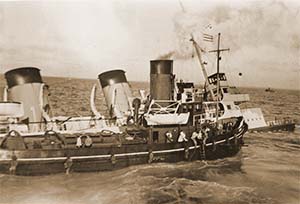
De Prinses Astrid hevig overhellend.
De Franse lokale autoriteiten hadden alles in het werk gezet om de reizigers op te vangen, te helpen om hun reis verder te zetten of naar huis terug te keren. Bussen uit de omgeving werden opgevorderd. Ook de bemanning van de Prinses Astrid werden achteraf in de nacht van dinsdag op woensdag met twee bussen terug naar Oostende gebracht. Het vreselijk ongeval had bij iedereen diepe sporen nagelaten. De geredde reizigers waren vol lof over de manier en beheersing waarop iedereen van de bemanning aan de redding heeft geholpen. Joseph Deswarte uit de keuken had bij aankomst in de haven te Duinkerke een bewusteloze reiziger van meer dan 100 kg spontaan op de schouder naar de ambulance gedragen. Op dergelijke momenten word een mens gedreven door adrenaline en doet soms daden die achteraf onmogelijk lijken.
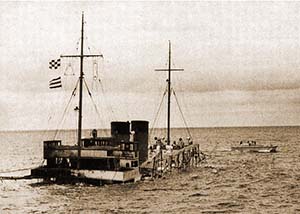
De Prinses Astrid volledig gezonken.
De Prinses Astrid lag gezonken op een zeer slechte plaats voor het scheepsverkeer. Na vele pogingen om eventueel het schip nog te kunnen bergen begon men stilaan bewust te worden dat het schip verloren was. Op elk geschikt moment en wanneer het getij dat toeliet, daalden duikers af om het schip te onderzoeken. Men hoopte hier op signalen om de Prinses Astrid te kunnen bergen. Men had de duikers ook aan het werk gezet om mogelijks ook wat van de lading te kunnen recupereren. Vooral voor die postzendingen die in eerste instantie als volledig verloren werden beschouwd. Het schip had ook twee auto’s aan boord. Toch probeerde een Antwerpse bedrijf in september nogmaals het wrak te onderzoeken. Deze kon nog 160 postzakken terug boven halen. De stoffelijke overschotten konden niet worden bereikt. Het was ook niet verwonderlijk dat bij elke gelegenheid het schip werd geplunderd van waardevolle voorwerpen. De zeegolven hadden ondertussen al veel schade aangericht. De masten waren verdwenen en men beweerde dat het schip al in twee stukken gebroken was. Door de slechte positie hadden al vele vaartuigen te dicht bij het wrak gevaren en zelfs schade opgelopen. Men riep dan ook de overheid op om het wrak goed te zichtbaar bebakenen voor de scheepsvaart.

De indeling van de compartimenten van de Prinses Astrid
In Oostende werden diverse activiteiten opgezet om het ongeval te herdenken en de slachtoffers te steunen. Het uitzonderlijke ongeval veroorzaakte veel leed. Vijf mannen van de crew hadden immers hun leven gelaten. Maar een belangrijke vraag die vooral moest beantwoord was de vraag of de Prinses Astrid nu op een mijn was gelopen of dat er in de machinekamer volgens sommige beweringen een explosie had voorgedaan met de gevolgen van dien. De Internationale Mijnvegerscommissie verklaarde op 23 juni al snel in een spoedvergadering dat het kanaal al drie jaar vrij van mijnen was gemaakt en dat de oorzaak van een mijn onwaarschijnlijk is. Het vermoeden was dat een vissersboot de mijn in zijn netten zou hebben meegesleept en aldaar hebben verplaatst naar de plaats van het ongeval. Of dat de mijn van de bodem is losgekomen door de stromingen.
Wat de aanwezigheid van mijnen betreft kunnen we slecht bevestigen dat er nog ettelijke jaren na de oorlog ondanks de verklaring dat het kanaal mijnenvrij zou zijn tal van vissers een gevaarlijke mijn in de netten hebben gevonden. Zo kreeg de vissersboot N725 Anna zes weken later begin augustus plots een zwaar voorwerp in de netten bij het binnenhalen. Er bleek een mijn in het net zonder voelpinnen die verder met een kabel nog verbonden was met andere mijnen. Het net brak door het grote gewicht en de mijnen verdwenen terug naar de bodem. De schipper keerde naar de haven en diende een verslag in bij de officiële instanties. De Zeemacht rukte uit met twee mijnvegers om het gebied te onderzoeken terwijl een algemeen communiqué voor de scheepvaart werd uitgestuurd om op te passen in de omgeving voor mijnen.
Een jaar later werden in Duinkerke alle mensen die aan redding hebben geholpen door de Minister Seghers van Verkeerswezen in de bloemen gezet en uit naam van de Belgische regering bedankt voor hun moedige daden. Enkele mensen ontvingen een ereteken. Zo werd kapitein Joos van de Cap Hadid onderscheiden met Ridder in de Kroonorde. Ook vele anderen werd uitvoerig bedankt voor hun moed en onderscheiden met een ereteken.
Toch bleek het niet zo evident om de oorzaak van het ongeval door een mijn als een feit te klasseren. Dat zou immers resulteren dat de slachtoffers zouden kunnen beschouwd als oorlogsslachtoffers. De nabestaanden hebben dan ook de rechtbank aan het werk gezet om hun verloren geliefden als oorlogsslachtoffers te kunnen verklaren. Vandaar dat het geschil in de vredesrechtbank van Oostende op 9 januari 1951 werd uitgesproken. In hun geval had de staat de keuze heeft gemaakt voor de meest voordelige uitkomst voor de nabestaanden. Een week voor het ongeval was het Belgisch leger nog officieel op vredesvoet teruggebracht. Dat resulteerde dat er geen oorlogsslachtoffers meer konden worden herkend.
De Prinses Astrid had eigenlijk voor de Oostende-Doverlijn een korte loopbaan van ongeveer 11 jaren. Het voor die tijd prachtige schip had samen met haar zusterschepen belangrijke taken tijdens de oorlog vervult. Amper één jaar na de volledige herstelling als maalboot werd het schip als het ware nog een 'vreselijk oorlogsslachtoffer'.

